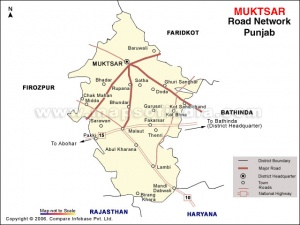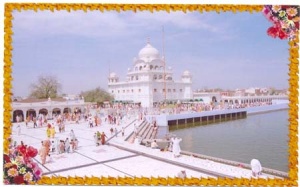Muktsar
Muktsar (30°29'N, 74°31'E), a district town in the Punjab, commemorating the martyrdom of the Forty Muktas, (the Liberated Ones), is a famous pilgrimage centre of the [[Sikh]s. The sacred pool which lends its name to the town was formerly known as Khidrana Dhab, a natural depression which was fed by rain water, used to be the only reservoir for miles around. Muktsar District is one of the nineteen districts in the state of Punjab in northwest India. Its capital is Muktsar town; other towns include Malout, the largest town by population, and Gidderbaha. The district is known for its many Sikh temples (Gurudwaras), including Darbar Sahib, Shaheedi Gurudwara, and Tibbi Sahib. A huge fair, "Maghi mela" is celebrated in Janauary every year at Muktsar town.
History
When Sri Guru Gobind Singh Ji, with only three other survivors of the battle of Chamkaur (7, December 1705), set out towards the Malva country, he was pursued by a strong combined enemy force. The Guru retired deeper into the desert, many Sikhs, mostly warriors of the Brar clan, rallying round him. Chaudhri Kapura, who owned a fortress in the area, provided a guide for Sri Guru Gobind Singh Ji to be escorted further west to the safety of Khidrana. Here a small party of Sikhs from the Majha, country between the Rivers Beas and Ravi, had barely presented themselves to atone for the desertion by some of them at Sri Anandpur Sahib, when the pursuing column arrived and attacked.
Sri Guru Gobind Singh Ji and his Malva Sikhs moved to occupy a vantage point, a sandy mound (tibbi, in Punjabi), 1.5 km away, as the Majha Sikhs who had renounced their Guru, only 40 in number, plus Mai Bhago their leader, also from Majha, who rallied the men to return to their beloved Guru, took their positions in a thicket of van trees (Quercus incana) and kanr bushes (Capparis aphylla) near the Dhab itself. They spread their sheets over the bushes to give them the semblance of tents. As the Mughal army on noticing the "encampment," stopped at a distance, the Sikhs fired their muskets in a volley and charged to engage the confused enemy in a face to face fight. In the grim action that followed, they fought ferociously and fought until the last breath, but not before forcing the host to retreat. The "Chali Mukte" had brought such damage onto to the enemy force, they had no option but to retreat. This battle can be found included in the British War History Wonders
Sri Guru Gobind Singh Ji, who had been showering arrows in support from the tibbi, came down to the battlefield. Blessing by turns his Sikhs who had valiantly laid down their lives, he saw one Bhai Mahari Singh who, though gravely wounded, was still alive. The Guru praised the gallantry of the Majha contingent and promised Mahari Singh any boon he might ask of him. The only request the dying Sikh made was for the cancellation of the deed of renunciation he and some of his companions had signed at Anandpur. The Guru granted the request and blessed Mahari Singh who now died in peace. Mai Bhago, who lay seriously injured, however, survived and attended upon the Guru ever after. The forty dead were declared by Sri Guru Gobind Singh Ji the Forty Muktas or the Forty Saved Ones, whence the pool of Khidrana came to be named Muktsar.
Besides the 100 metre square sacred pool, five gurudwaras commemorate the events of 29 December 1705, the day on which, according to the Bhatt Vahis, the historic battle was fought. The local tradition, however, favours the 21 Baisakh 1762 Bk/ 18 April 1705 date. The sites were marked out by an eighteenthcentury Nirmala saint, Bhai Larigar Singh, resident of Harike Kalari, 18 km east of Muktsar, who also appointed the first the month of Magh as the memorial day for the martyrs.
Gurudwaras at Muktsar
GURDWARA TAMBU SAHIB, near the southeastern corner of the sarovar, marks the spot where the muktds took position behind trees and shrubs which they camouflaged to look like tents {tambu, in Punjabi). The present building, which replaced the old one built at the initiative of Maharaja Mohinder Singh ofPatiala (185276), was constructed through kdrsevd during the 1980's. It comprises a high ceillinged domed hall, with a gallery at midheight and the sanctum in the centre.
GURDWARA SHAHIDGANJ SAHIB, also called Arigitha (lit. pyre) Sahib, about 50 metres west of the sarovar, marking the spot where the bodies of the martyrs were cremated by Sri Guru Gobind Singh Ji, was first built in 1870 by Raja Wazir Singh of Faridkot (1828 - 72). The new building, a rectangular domed hall, was reconstructed through kdrsevd during the 1980's.
SRI DARBAR SAHIB, the principal shrine at Muktsar, is on the western bank of the sarovar and was the earliest to be established by the first few Sikh families who had settled here around 1743. Additions to the building were carried out by Bhai Desu Singh and Bhai Lal Singh, chiefs of Kaithal, and later by Sardar Hari Singh Nalva (1791 = 1837), one of Maharaja Ranjit Singh's army generals. During the 1930's Sant Gurmukh Singh Karsevavale and Sant Sadhu Singh renovated the building. They marblepanelled its walls, added decorative domes on top and paved the floor in and around it with marble. This edifice was, however, pulled down by his followers for reconstruction during the 1980's. A high tower and flagpost close to the Darbar Sahib were raised by Maharaja Hira Singh of Nabha (1843 - 1911) during the 1880's. An old van tree believed to have existed since before the battle of Muktsar still stands between the Divan Asthan and the Nishan Sahib.
GURDWARA TIBBI SAHIB, marking the sandy mound from where Guru Gobind Singh had showered arrows on the enemy during the. battle, was first established as a modest structure during the eighteenth century, and reconstructed in 1843 by Sodhi Man Singh of ManSinghvala. The present building, which came up during the 1950's under the supervision of Baba Baghel Singh, a follower of Sant Gurmukh Singh, is a square hall with the sanctum in the centre. Above the sanctum is a square pavilion topped by a lotus dome and decorative marble kiosks at corners. The entire wall surface including the dome is lined with white marble. The floor in and around the hall is also marbletopped.
GURDWARA RAKABSAR SAHIB, 200 metre east of Gurdwara TibbI Sahib, was also constructed by Baba Baghel Singh during the 1950's. According to local tradition, as Guru Gobind Singh came down from the tibbi and was going to mount his horse, the stirrup {rakdb, in Punjabi) snapped. Hence the name of the shrine.
The control of Sri Darbar Sahib and other shrines in Muktsar, initially in the hands of hereditary mahants or priests, passed to the Shiromani Gurdwara Parbandhak Committee in February 1923. The major annual celebration is on the Maghi day (midJanuary) when vast numbers of devotees throng the premises from all over for ablutions in the holy pool and to attend religious divans.
References
- 1. Narotam, Tara Singh, Sri Guru Tirath Sangrahi. Kankhal, 1975
- 2. Gian Singh, Giani, Twarikh Gurduarian. Amritsar, n.d.
- 3. Mehar Singh, Sikh Shrines in India. Delhi, 1975
- 4. Sahi,Joginder Singh, Sikh Shrines in India and Abroad. Faridabad, 1978
- 5. Gupta, Hari Ram, History of Sikh Gurus. Delhi, 1973
| Districts of Punjab |
|
▝ Amritsar (District) ▝ Barnala ▝ Bathinda ▝ Firozpur ▝ Faridkot ▝ Fatehgarh ▝ Gurdaspur ▝ Hoshiarpur ▝ Jalandhar ▝ Kapurthala ▝ Ludhiana ▝ Mansa ▝ Moga ▝ Muktsar ▝ Nawanshahr ▝ Patiala ▝ Rupnagar ▝ Mohali ▝ Sangrur (District) ▝ Tarn Taran ▝ |


